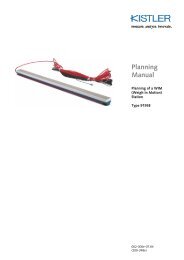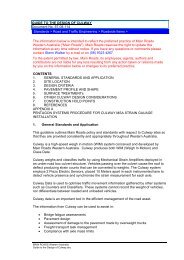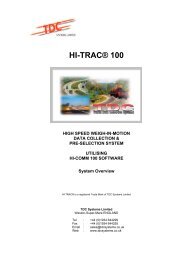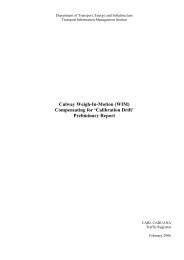AP-G84/04 Best practice in road use data collection, analysis ... - WIM
AP-G84/04 Best practice in road use data collection, analysis ... - WIM
AP-G84/04 Best practice in road use data collection, analysis ... - WIM
You also want an ePaper? Increase the reach of your titles
YUMPU automatically turns print PDFs into web optimized ePapers that Google loves.
Accessed by AR - ARRB TRANSPORT RESEARCH on <strong>04</strong> Feb 2005<br />
Aust<strong>road</strong>s 20<strong>04</strong><br />
— 21 —<br />
<strong>Best</strong> Practices <strong>in</strong> Road Use Data Collection, Analysis and Report<strong>in</strong>g<br />
Some examples of us<strong>in</strong>g Table 9 are as follows:<br />
(a) If the short-term day count on a Wednesday on a rural urban fr<strong>in</strong>ge site is 10,000 vehicles<br />
per 24 hour, then the estimated AADT is 1.10 × 10,000 = 11,000 vehicles.<br />
(b) If the short-term part-day (7 a.m. – 9 a.m.) count on a Wednesday at the same rural urban<br />
fr<strong>in</strong>ge site is 1,300 vehicle per 2 hour, then the estimated AADT is 8.61 × 1300 = 11,193<br />
vehicles.<br />
In general, counts of very short durations of a few hours or even 12 hours are not reliable for traffic<br />
forecast<strong>in</strong>g. With automatic count<strong>in</strong>g equipment now commonly deployed, the extra cost of<br />
collect<strong>in</strong>g <strong>data</strong> on more days should be m<strong>in</strong>imal. The best way to ensure consistency amongst RAs<br />
is for each RA to collect robust <strong>data</strong> sets – collect<strong>in</strong>g <strong>data</strong> over a consecutive period of, say, seven<br />
days.<br />
Based on some NSW count <strong>data</strong>, Botterill and Luk (1998) reported that regression <strong>analysis</strong> is<br />
suitable for determ<strong>in</strong><strong>in</strong>g an adjustment factor to convert a sample count to an estimated AADT and<br />
estimat<strong>in</strong>g the relevant accuracy. Regression <strong>analysis</strong> could be preferable to cluster <strong>analysis</strong> for<br />
some <strong>use</strong>rs beca<strong>use</strong> the statistics from regression are well-known. The NSW <strong>data</strong> were separated<br />
<strong>in</strong>to monthly counts and regression equations were derived relat<strong>in</strong>g AADT to <strong>road</strong> type, count type<br />
(axle counts or classified counts), and AADT strata. It was found that AADT strata had m<strong>in</strong>imal<br />
effect and a recommended regression equation is as follows (without us<strong>in</strong>g the constant term):<br />
AADT = β × Vol + ε<br />
where AADT is the count for each Permanent Station,<br />
β is the seasonal adjustment factor to be estimated,<br />
Vol is the daily volume for each nom<strong>in</strong>al period (either a three-day or a six-day week) <strong>in</strong> the four weeks<br />
<strong>in</strong> any month for each permanent stations,<br />
ε is the error term represent<strong>in</strong>g the deviation from the regression l<strong>in</strong>e.<br />
Botterill and Luk (1998) further provided a systematic view of the tasks <strong>in</strong>volved <strong>in</strong> a traffic count<strong>in</strong>g<br />
program and the calculation of VKTs (Figure 8). The framework highlights the follow<strong>in</strong>g issues:<br />
Need for a strategic view <strong>in</strong> implement<strong>in</strong>g a count<strong>in</strong>g program (fund<strong>in</strong>g issues and on-go<strong>in</strong>g<br />
ma<strong>in</strong>tenance);<br />
Appropriate <strong>analysis</strong> techniques (cluster or regression for pattern recognition, seasonal<br />
adjustments, etc.);<br />
Reliability check over many years and between years;<br />
Clear operational producers.<br />
Some of the issues have been mentioned earlier <strong>in</strong> Section 2 and are addressed further below.

















